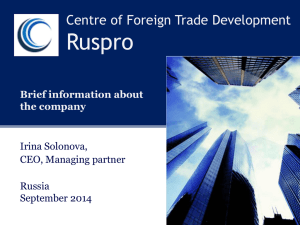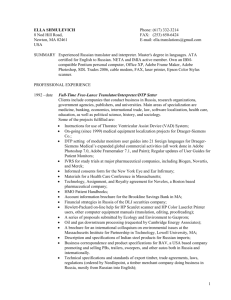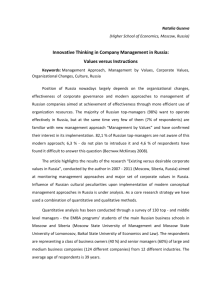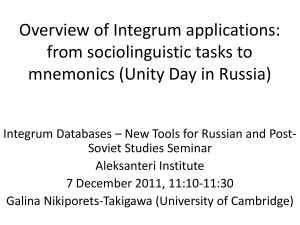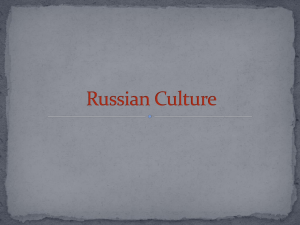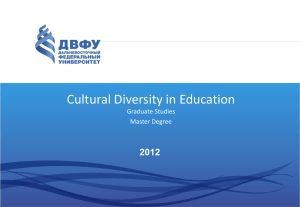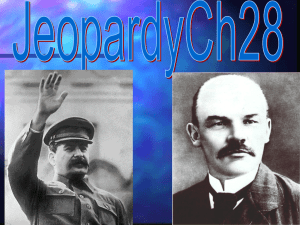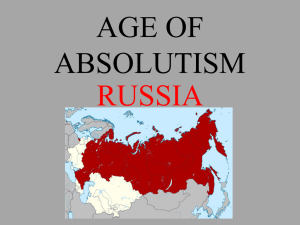CIVIL SOCIETY
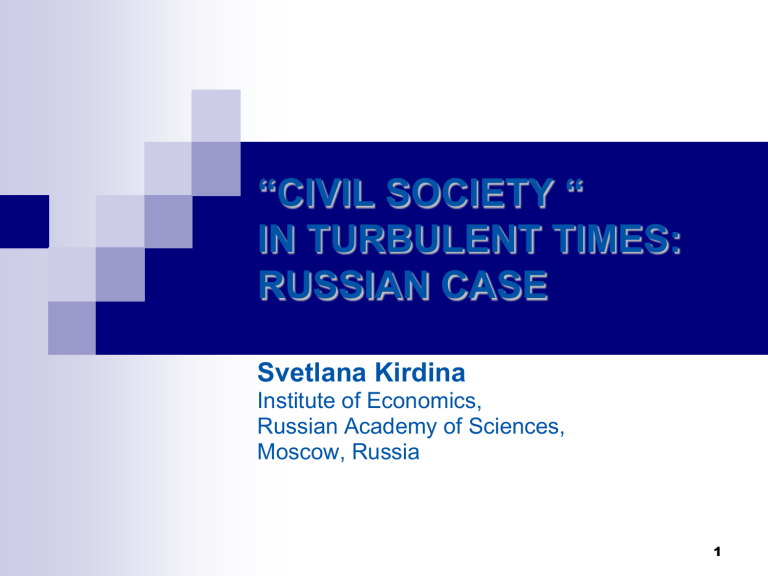
“CIVIL SOCIETY “
IN TURBULENT TIMES:
RUSSIAN CASE
Svetlana Kirdina
Institute of Economics,
Russian Academy of Sciences,
Moscow, Russia
1
Outline
“Civil society” = an Ideologem?
“Civil society” and a state: opponents or partners?
“Civil society” in Russia: theory and empirical data
2
The importance of terms’ meaning
Once disciple of Confucius asked his
Teacher (488 BC): “New governor is going to involve you in the state administration.
Where do you start?”. Confucius replied:
"First we need to refine the names that do not correspond to the essence ... If the words are unfavorable, the case will not be going well ... (Lun Yu, XIII, p. 8)
3
“ Civil society” in different ideological contexts (examples)
The New Left : civil society has a key role in defending people against the capitalist state and the market and in asserting the collective will to influence the state;
Neo-liberals : civil society needs the market and is created for the satisfaction of individual interests and private property in accordance with liberal values. .
[
4
“Civil society” as
“liberal” Ideologem
CSI (Civil Society Index): 2 of 4 parameters characterize the basic freedoms and values;
CSSI (Civil Society Strength Index): 1 of
2 groups of parameters is named as Civil
Society values factor;
GCSI (Global Civil Society Index): 2 of 5 parameters reflect the distribution of tolerance values.
5
Civil society and a state
Civil society is the state (since Thomas
Hobbes, John Locke)
Civil society is an opponent of the state, or
“political superstructure” (since the Great Scots
David Hume, Adam Smith, Patrick Ferguson)
Civil society is a complement rather than an alternative to the state , “the state is seen as a precondition of civil society” (Whaites, 1996;
Zaleski, 2006)
6
Civil society and a state
(Russian version)
Civil society is a part of the state . Its main objective is to promote the social integration through: o o o
Legitimization of state power;
Public control of state decisions;
Participation in the process of state decision making.
(Russian school of constitutional economics,
Russian civil and public law studies).
7
Table 1. In your opinion, what could promote the welfare of Russia, %?
(Levada-Center. Press release 21.01.2010. What is democracy and whether it is necessary in Russia?)
The strengthening of
“the vertical of power”
The strengthening of civil rights and freedoms, civil society
Neither one nor the other
Don’t know
December
2004
31
42
13
14
December
2005
December
2006
December
2009
31
38
14
17
29
42
11
18
31
48
8
12
8
Table 2. Do you think the majority of public movements and initiatives in modern Russia is emerging…
Levada-Center. Press release 25.06.2010. Problems of social and political participation.
on the private initiative of citizens,
“bottom-up”, independently of the government or other political forces initiated by the authorities initiated by opposition political forces initiated by external forces interested in a particular way of Russia's development
Don’t know
June 2008 June 2010
14
32
21
11
22
13
30
22
13
22
9
Table 3. What type of state would you like to see to exist in Russia?
Levada-Center. Press release 16.03.2010. State and society interrelations in Russian public opinion.
March
1998
February
2006
February
2010
A unitary centralized state with the heads of local authorities appointed by the Center
State with the most extensive rights of local authorities and central government coordinating their interests
Don’t know
25
52
23
41
39
20
46
36
19
10
Table 4. In your opinion, on which of the following principles a society, in which you want to live, should be based?
Levada-Center. Press release 14.01.2011. On state and society interrelations.
The authorities should take care of people
People should be able to obtain from authorities what they need
Don’t know
November February
2001 2006
December
2006
December
2007
December
2010
66
33
3
68
28
4
74
21
5
66
30
4
65
29
6
11
Institutional matrices theory
(X- and Y-theory) as one of theoretical explanations
Kirdina S. G. Institutional Matrices and Development in Russia (2 edition).
Novosibirsk, 2001 (In Russian).
Kirdina S. The Institutional Matrices Theory in the Context of Modern
Sociology. /Visions and Divisions: the Russian Outlook The Russian
Academy of Sciences - The Russian Society of Sociologists. - Moscow-
Helsinki, 2001.
Kirdina S. Fundamental Difference in the Transformation Process between
Russia and East European Countries // Berliner Osteuropa Info, №
16/2001.
Kirdina S. Institutional Matrices and Institutional Changes / Economic
Transformation and Evolutionary Theory of J. Schumpeter. The 5th
International Symposium on Evolutionary Economics, Pushchino, Moscow region, Russia, 2003.
Institutional matrix in sociology / Sociological encyclopedia. Moscow, 2003
(in Russian),
Institutional matrices theory/ Sociological dictionary. Moscow, 2010 (in
Russian).
12
13
X- and Y-matrices
Redistributive economy
X
Y
Market economy
Combinations of X- and Ymatrices
Y
X X
Y
Russia, China, and North American most of Asian and countries and most of
Latin American countries European countries
14
X- and Y-institutions in politics and their functions
Functions of institutions X-institutions Y-institutions
1.Territorial administrative organization of the state
Administrative division
(unitarity)
Federative structure
(federation)
2. Governance system (flow of decision making)
3.Type of interaction in the order of decision making
Vertical hierarchical authority with Centre on the top
General assembly and unanimity
Self-government and subsidiarity
Multi-party system and democratic majority
Election 4. Filling of governing positions
Appointment
5. Feed-back mechanism Appeals to higher levels of hierarchical authority
Law suits
15
Conclusion
“Civil society” remains an ideologem rather than a rigorous scientific concept.
A critical interpretation of civil society discourse needs placing it in the context of contingent policy regimes defined by institutional factors.
A version of civil society discourse contextualized in the Russian transitional society calls for interpreting it not as an opponent of the state but as a part of the state with main objective to promote the social integration.
16
Thank you for your attention!
Contacts : www.kirdina.ru
kirdina@bk.ru
17




